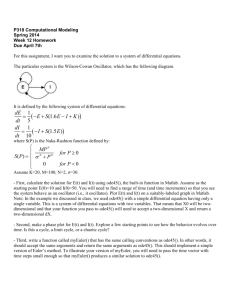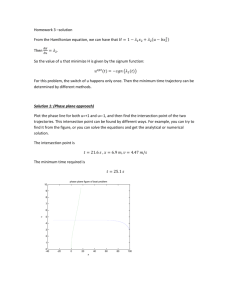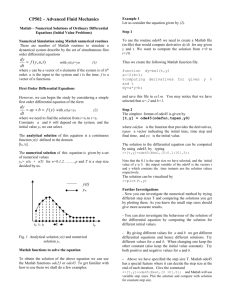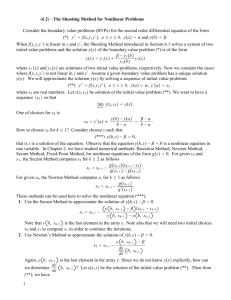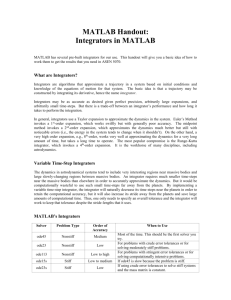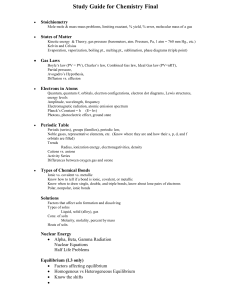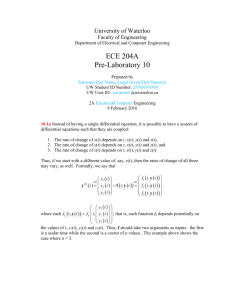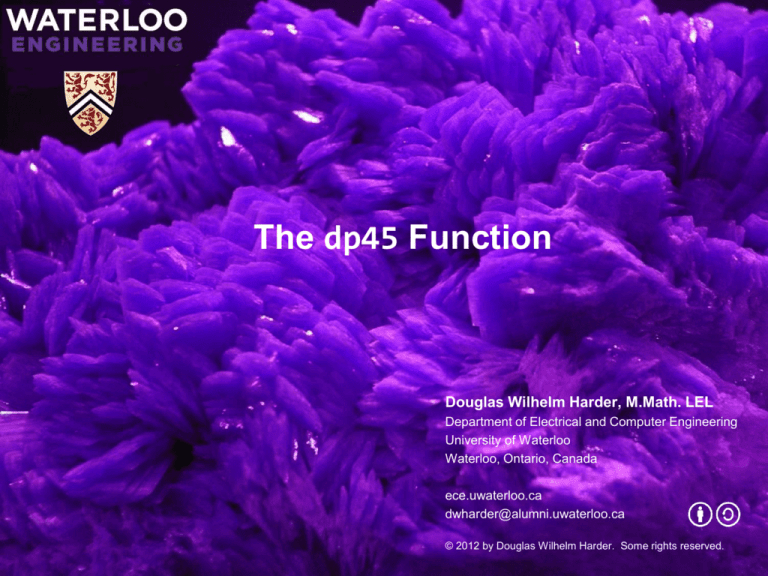
The dp45 Function
Douglas Wilhelm Harder, M.Math. LEL
Department of Electrical and Computer Engineering
University of Waterloo
Waterloo, Ontario, Canada
ece.uwaterloo.ca
dwharder@alumni.uwaterloo.ca
© 2012 by Douglas Wilhelm Harder. Some rights reserved.
The dp45 Function
Outline
This topic will compare the function dp45 and the built-in
Matlab function ode45
– We will describe boundary-value problems
– We will look at solutions with linear ODEs
– We will consider solutions for non-linear ODEs
• This will require successive approximations using the secant
method
2
The dp45 Function
Outcomes Based Learning Objectives
By the end of this laboratory, you will:
– Understand the effectiveness of Dormand Prince
3
The dp45 Function
Examples
We will examine the different results from dp45 and
ode45 for numerous different initial-value problems
– We will look at three differential equations that have known
solutions
– We will then add discontinuous forcing functions
4
The dp45 Function
One Change
Right now, we only either double or halve h, as dictated
by the calculated value s
– Now, we will increase or decrease h by factors of 2 or 2
if s >= 2
h = 2*h;
else % s >= sqrt(2)
h = sqrt(2)*h;
end
if s < 1/sqrt(2)
h = h/2;
else % s < 1
h = h/sqrt(2);
end
% make sure h does not get too small
while t_out(k) + h == t_out(k)
h = sqrt(2)*h;
end
5
The dp45 Function
Example 1
We will compare dp45 and ode45 by looking at various
examples
– We will find problems with each...
– You are welcome to look at the source code for ode45 by looking
at the source code in the Matlab directory, e.g.,
C:\Program Files\MATLAB\R2010a\toolbox\matlab\funfun\ode45.m
6
The dp45 Function
7
Example 1
We start with a few initial-value problems for which we
have solutions:
y 2 t 3 y 1 t y t sin t
y 0 1
y
1
0 0.5
y7 a : t
e
1
2
5 2 12
e
2 3
5 3 t
2
5 1
cos t
3 2 3
5 3 t
function [dy] = f7a( t, y )
dy = [y(2);
sin(t) - y(1) - 3*y(2)];
end
function [y] = y7a_soln( x )
y = exp((sqrt(5) - 3)*x/2) * (sqrt(5)/2 + 2/3) ...
+ exp(-(sqrt(5) + 3)*x/2)*(2/3 - sqrt(5)/2) ...
- cos(x)/3;
end
The dp45 Function
Example 1
The commands that were run include
[t7a1, y7a1] = dp45( @f7a, [0, 10], [1, 0.5]', 0.1, 1e-3 );
[t7a2, y7a2] = ode45( @f7a, [0, 10], [1, 0.5]' );
8
The dp45 Function
9
Example 1
Both dp45 and ode45 give good approximations:
.... ode45
.... dp45
The dp45 Function
10
Example 1
If we subtract off the correct solution, the picture is
different: ode45 has a worse error but uses more points
– The maximum error is as large as 1.4018 × 10–4
.... ode45
.... dp45
The dp45 Function
11
Example 1
If we zoom in on the errors, we quickly note that dp45 has
a maximum absolute error on the order of 2.7291× 10–6
– Maximum ode45 error: 1.4018 × 10–4
.... ode45
.... dp45
The dp45 Function
12
Example 1
If we plot the step sizes (h), it is larger for dp45 even
though it has a smaller error and less refined
.... ode45
.... dp45
The dp45 Function
13
Example 1
This table summarizes some of the properties:
Time
Points
Require
Used
d (s)
Root Mean
Squared
Error
Estimate
of y7b(10)
Absolute Error
of
y7a(10)
dp45
41
0.004593 1.6694 × 10–6
0.318839175984814
8.0206 × 10–7
ode45
113
0.005655 2.5124 × 10–5
0.318844791778805
6.4179 × 10–6
y7 a 10 0.318838373926729
The dp45 Function
Example 1
Source code:
tic; [t7a1, y7a1] = dp45( @f7a, [0, 10], [1, 0.5]', 0.1, 1e-3 ); toc
tic; [t7a2, y7a2] = ode45( @f7a, [0, 10], [1, 0.5]' ); toc
hold off
plot( t7a1, y7a1(1,:), 'b.' );
hold on
plot( t7a2, y7a2(:,1), 'r.' );
hold off
plot( t7a1, y7a1(1,:) - y7a_soln( t7a1 ), 'b.' );
hold on
plot( t7a2, y7a2(:,1) - y7a_soln( t7a2 ), 'r.' );
d7a1 = max( abs( y7a1(1,:) - y7a_soln( t7a1 ) ) )
ylim( [-2*d7a1, 2*d7a1] );
d7a2 = max( abs( y7a2(:,1) - y7a_soln( t7a2 ) ) )
hold off
plot( t7a1( 1:end - 1 ), diff( t7a1 ), 'b.' );
hold on
plot( t7a2( 1:end - 1 ), diff( t7a2 ), 'r.' );
length( t7a1 )
length( t7a2 )
sqrt( norm( y7a1(1,:) - y7a_soln( t7a1 ) )^2/length( t7a1 ) )
sqrt( norm( y7a2(:,1) - y7a_soln( t7a2 ) )^2/length( t7a2 ) )
abs( y7a1(1,end) - y7a_soln( t7a1(end) ) )
abs( y7a2(end,1) - y7a_soln( t7a2(end) ) )
y7a1(1,end)
y7a2(end,1)
14
The dp45 Function
15
Example 2
Let’s change it up a bit and let the solution grow:
y 2 t 3 y 1 t y t sin t
y 0 1
y 1 0 0.5
y7 b : t
5
8 12
e
13 e
13
26
3
2
cos t sin t
13
13
1
2
13 3 t
8 5
13
13 26
13 3 t
function [dy] = f7b( t, y )
dy = [y(2);
sin(t) + y(1) - 3*y(2)];
end
function [y] = y7b_soln( t )
y = exp( (sqrt(13) - 3)*t/2)*(sqrt(13)*5/26 + 8/13) ...
+ exp(-(sqrt(13) + 3)*t/2)*(8/13 - sqrt(13)*5/26) ...
- cos(t)*3/13 - 2/13*sin(t);
end
The dp45 Function
Example 2
We will run the same commands:
[t7b1, y7b1] = dp45( @f7b, [0, 10], [1, 0.5]', 0.1, 1e-3 );
[t7b2, y7b2] = ode45( @f7b, [0, 10], [1, 0.5]' );
16
The dp45 Function
17
Example 2
Both dp45 and ode45 appear to approximate the function
correctly
.... ode45
.... dp45
The dp45 Function
18
Example 2
If we subtract off the correct solution, however, we get a
very different picture—ode45 uses more points but has a
significantly worse error
– The maximum error is as large as 4.5891 × 10–4
.... ode45
.... dp45
The dp45 Function
19
Example 2
If we zoom in on the errors, we quickly note that dp45 has
a maximum absolute error on the order of 2.2518 × 10–6
.... ode45
.... dp45
The dp45 Function
20
Example 2
If we plot the step sizes (h), it is larger for dp45 even
though it has a smaller error and less refined
.... ode45
.... dp45
The dp45 Function
21
Example 2
Given that y7b(10) = 27.304328219066473, this table
summarizes some of the properties:
Time
Points
Required
Used
(s)
Root Mean
Squared
Error
Estimate
of y7b(10)
Absolute
Error of
Estimate
dp45
45
0.004659
1.0153 × 10–6
27.304328798513346
5.7945 × 10–7
ode45
81
0.004271
1.6109 × 10–4
27.304591337428629
2.6312 × 10–4
The dp45 Function
Example 2
Source code:
tic; [t7b1, y7b1] = dp45( @f7b, [0, 10], [1, 0.5]', 0.1, 1e-3 ); toc
tic; [t7b2, y7b2] = ode45( @f7b, [0, 10], [1, 0.5]' ); toc
hold off
plot( t7b1, y7b1(1,:), 'b.' );
hold on
plot( t7b2, y7b2(:,1), 'r.' );
hold off
plot( t7b1, y7b1(1,:) - y7b_soln( t7b1 ), 'b.' );
hold on
plot( t7b2, y7b2(:,1) - y7b_soln( t7b2 ), 'r.' );
d7b1 = max( abs( y7b1(1,:) - y7b_soln( t7b1 ) ) )
ylim( [-2*d7b1, 2*d7b1] );
d7b2 = max( abs( y7b2(:,1) - y7b_soln( t7b2 ) ) )
hold off
plot( t7b1( 1:end - 1 ), diff( t7b1 ), 'b.' );
hold on
plot( t7b2( 1:end - 1 ), diff( t7b2 ), 'r.' );
length( t7b1 )
length( t7b2 )
sqrt( norm( y7b1(1,:) - y7b_soln( t7b1 ) )^2/length( t7b1 ) )
sqrt( norm( y7b2(:,1) - y7b_soln( t7b2 ) )^2/length( t7b2 ) )
abs( y7b1(1,end) - y7b_soln( t7b1(end) ) )
abs( y7b2(end,1) - y7b_soln( t7b2(end) ) )
y7b1(1,end)
y7b2(end,1)
22
The dp45 Function
Example 3
23
Here is a different differential equation, the solution of
which is in terms of the Airy Ai and Bi functions:
2 y 2 t y 1 t 10ty t 0
y 0 0
y 1 0 1
35 35
35 35
Bi
Ai
1
80
t
Ai
Bi
1
80
t
80
80
80
80
e
3
3
35
3 5 1 3 5
5
1 5
Bi
Ai
Bi
Ai
80
80
80
80
1
t
4
y7 c : t
function [dy] = f7c( t, y )
dy = [y(2);
0 - 5*t*y(1) + 0.5*y(2)];
end
function [y] = y7c_soln( t )
d = 5^(1/3)/80;
y = real( 5^(-1/3)*exp(t/4).*(
...
airy(2, d)*airy(d*(1 - 80*t)) ...
- airy(d)*airy(2, d*(1 - 80*t)) ...
)/(airy(3, d)*airy(d) - airy(2, d)*airy(1, d)) );
end
The dp45 Function
Example 3
We will reduce the absolute tolerance to eabs = 10–2
[x7c1, u7c1] = dp45( @f7c, [0, 10], [0, 1]', 0.1, 1e-2 );
[x7c2, u7c2] = ode45( @f7c, [0, 10], [0, 1]' );
24
The dp45 Function
Example 3
Both dp45 and ode45 appear to approximate the function
correctly
.... ode45
.... dp45
25
The dp45 Function
Example 3
Subtract off the correct solution: ode45 is again, worse
– The maximum error is as large as 3.0005 × 10–2
.... ode45
.... dp45
26
The dp45 Function
Example 3
If we zoom in on the errors, we quickly note that dp45 has
a maximum absolute error on the order of 6.1138 × 10–4
.... ode45
.... dp45
27
The dp45 Function
Example 3
If we plot the step sizes (h), it is larger for dp45 even
though it has a smaller error and less refined
.... ode45
.... dp45
28
The dp45 Function
29
Example 3
Given that y7c(10) = –0.891495239411208, this table
summarizes some of the properties:
Time
Points
Required
Used
(s)
Root Mean
Squared
Error
Estimate
of y7c(10)
Absolute
Error of
Estimate
dp45
159
0.026004
2.5791 × 10–4
–0.892244984737689
5.7015 × 10–4
ode45
245
0.009992
9.3836 × 10–3
–0.921500422481734
3.0005 × 10–2
The dp45 Function
Example 3
Source code:
tic; [t7c1, y7c1] = dp45( @f7c, [0, 10], [0, 1]', 0.1, 1e-2 ); toc
tic; [t7c2, y7c2] = ode45( @f7c, [0, 10], [0, 1]' ); toc
hold off
plot( t7c1, y7c1(1,:), 'b.' );
hold on
plot( t7c2, y7c2(:,1), 'r.' );
hold off
plot( t7c1, y7c1(1,:) - y7c_soln( t7c1 ), 'b.' );
hold on
plot( t7c2, y7c2(:,1) - y7c_soln( t7c2 ), 'r.' );
d7c1 = max( abs( y7c1(1,:) - y7c_soln( t7c1 ) ) )
ylim( [-2*d7c1, 2*d7c1] );
d7c2 = max( abs( y7c2(:,1) - y7c_soln( t7c2 ) ) )
hold off
plot( t7c1( 1:end - 1 ), diff( t7c1 ), 'b.' );
hold on
plot( t7c2( 1:end - 1 ), diff( t7c2 ), 'r.' );
length( t7c1 )
length( t7c2 )
sqrt( norm( y7c1(1,:) - y7c_soln( t7c1 ) )^2/length( t7c1 ) )
sqrt( norm( y7c2(:,1) - y7c_soln( t7c2 ) )^2/length( t7c2 ) )
abs( y7c1(1,end) - y7c_soln( t7c1(end) ) )
abs( y7c2(end,1) - y7c_soln( t7c2(end) ) )
y7c1(1,end)
y7c2(end,1)
30
The dp45 Function
Example 3
In order for ode45 to return the same accuracy as our
implementation of dp45, we must increase the absolute
and relative tolerances
[t7c1, y7c1] = dp45( @f7c, [0, 10], [0, 1]', 0.1, 1e-2 );
[t7c2, y7c2] = ode45( @f7c, [0, 10], [0, 1]', ...
odeset( 'RelTol', 5e-5, 'AbsTol', 5e-8 ) );
Thus, in order for ode45 to achieve the same accuracy of
dp45, we must use 477 points as compared to dp45 using
159 — a 200 % increase
31
The dp45 Function
Example 4
Let’s add a discontinuous forcing function:
y 2 t 3 y 1 t y t 2 cos 2t 1
y 0 1
y 1 0 0.5
function [dy] = f7d( t, y )
dy = [y(2);
2*ceil(cos(2*t)) - 1 - y(1) - 3*y(2)];
end
32
The dp45 Function
Example 4
The forcing function 2 cos 2t 1 is a square wave
33
The dp45 Function
Example 4
The exact solution on the interval t = [0, 10] can be found
in Maple:
> dsolve( {(D@@2)(y)(t) + 3*D(y)(t) + y(t) = piecewise(
t <
Pi/4, 1,
t < 3*Pi/4, -1,
t < 5*Pi/4, 1,
t < 7*Pi/4, -1,
t < 9*Pi/4, 1,
t < 11*Pi/4, -1,
1
), y(0) = 1, D(y)(0) = 1/2 } );
34
The dp45 Function
Example 4
This solution can be converted into Matlab:
function [y] = y7d( t )
s10 = sqrt(5)/10;
s35 = 3/5*sqrt(5);
sp = (sqrt(5) + 3)/2;
e0p = exp(-sp*t);
e1p = exp(-( -1/4*pi
e3p = exp(-( -3/4*pi
e5p = exp(-( -5/4*pi
e7p = exp(-( -7/4*pi
e9p = exp(-( -9/4*pi
e11p = exp(-(-11/4*pi
y = (t
(t
(t
(t
+
+
+
+
+
+
t)*sn);
t)*sn);
t)*sn);
t)*sn);
t)*sn);
t)*sn);
.*( 1 + (e0n - e0p)*s10) + ...
3*pi/4).*(-1 + (e0n - e0p)*s10 + s35*(-e1p + e1n) + e1n + e1p) + ...
5*pi/4).*( 1 + (e0n - e0p)*s10 + s35*(-e1p + e3p - e3n + e1n) + e1n - e3n - e3p + e1p) + ...
7*pi/4).*(-1 + (e0n - e0p)*s10 + e5p + s35*(e5n - e5p - e1p + e3p - e3n + e1n) ...
+ e1n + e5n - e3n - e3p + e1p) + ...
(t >= 7*pi/4 & t < 9*pi/4).*( 1 + (e0n - e0p)*s10 - e7p + e5p ...
+ s35*(e5n - e7n - e5p + e7p - e1p + e3p - e3n + e1n) ...
+ e1n + e5n - e3n - e7n - e3p + e1p) + ...
(t >= 9*pi/4 & t < 11*pi/4).*(-1 + (e0n - e0p)*s10 + e9p - e7p + e5p ...
+ s35*(e5n - e7n - e9p + e9n - e5p + e7p - e1p + e3p - e3n + e1n) ...
+ e1n + e5n - e3n - e7n - e3p + e1p + e9n) + ...
(t >= 11*pi/4)
.*( 1 + (e0n - e0p)*s10 + e9n + e1n - e3n + e9p ...
+ s35*(-e11n + e5n + e11p - e7n - e9p + e9n - e5p + e7p - e1p + e3p - e3n + e1n) ...
+ e1p - e3p - e11p - e11n + e5p - e7n - e7p + e5n);
end
< pi/4)
>= 1*pi/4 & t <
>= 3*pi/4 & t <
>= 5*pi/4 & t <
t)*sp);
t)*sp);
t)*sp);
t)*sp);
t)*sp);
t)*sp);
sn = (sqrt(5) - 3)/2;
e0n = exp( sn*t);
e1n = exp( ( -1/4*pi +
e3n = exp( ( -3/4*pi +
e5n = exp( ( -5/4*pi +
e7n = exp( ( -7/4*pi +
e9n = exp( ( -9/4*pi +
e11n = exp( (-11/4*pi +
35
The dp45 Function
Example 4
The commands that were run include
[t7d1, y7d1] = dp45( @f7d, [0, 10], [1, 0.5]', 0.01, 1e-4 );
[t7d2, y7d2] = ode45( @f7d, [0, 10], [1, 0.5]' );
36
The dp45 Function
Example 4
Both dp45 and ode45 appear to approximate the function
correctly, but there are already visible variations
.... ode45
.... dp45
37
The dp45 Function
Example 4
Subtract off the correct solution: ode45 is again, worse
– The maximum error is as large as 7.3442 × 10–3
.... ode45
.... dp45
38
The dp45 Function
Example 4
If we zoom in on the errors, we quickly note that dp45 has
a maximum absolute error on the order of 1.7073 × 10–5
.... ode45
.... dp45
39
The dp45 Function
40
Example 4
The step size (h) is both larger and smaller for dp45
.... ode45
.... dp45
The dp45 Function
41
Example 4
By plotting the logarithm of the step size, we see that to
obtain the required precision, h must be small around the
discontinuities dp45
.... ode45
.... dp45
The dp45 Function
42
Example 4
Given that y7d(10) = 0.139902216337457, this table
summarizes some of the properties:
Time
Points
Required
Used
(s)
Root Mean
Squared
Error
Estimate
of y7d(10)
Absolute
Error of
Estimate
dp45
455
0.101044
9.7313 × 10–6
0.139906356637503
4.1403 × 10–6
ode45
229
0.011548
2.8676 × 10–3
0.142657236323302
2.7550 × 10–3
dp45 uses many more points but successfully navigates the discontinuities
The dp45 Function
Example 4
Source code:
tic; [t7d1, y7d1] = dp45( @f7d, [0, 10], [1, 0.5]', 0.1, 1e-2 ); toc
tic; [t7d2, y7d2] = ode45( @f7d, [0, 10], [1, 0.5]' ); toc
hold off
plot( t7d1, y7d1(1,:), 'b.' );
hold on
plot( t7d2, y7d2(:,1), 'r.' );
hold off
plot( t7d1, y7d1(1,:) - y7d_soln( t7d1 ), 'b.' );
hold on
plot( t7d2, y7d2(:,1) - y7d_soln( t7d2 ), 'r.' );
d7d1 = max( abs( y7d1(1,:) - y7d_soln( t7d1 ) ) )
ylim( [-2*d7d1, 2*d7d1] );
d7d2 = max( abs( y7d2(:,1) - y7d_soln( t7d2 ) ) )
hold off
plot( t7d1( 1:end - 1 ), log(diff( t7d1 )), 'b.' );
hold on
plot( t7d2( 1:end - 1 ), log(diff( t7d2 )), 'r.' );
length( t7d1 )
length( t7d2 )
sqrt( norm( y7d1(1,:) - y7d_soln( t7d1 ) )^2/length( t7d1 ) )
sqrt( norm( y7d2(:,1) - y7d_soln( t7d2 ) )^2/length( t7d2 ) )
abs( y7d1(1,end) - y7d_soln( t7d1(end) ) )
abs( y7d2(end,1) - y7d_soln( t7d2(end) ) )
y7d1(1,end)
y7d2(end,1)
43
The dp45 Function
Example 5
Let’s change it up a bit and let the solution grow:
y 2 t 3 y 1 t 2 cos 2t 1 y t sin t
y 0 1
y 1 0 0.5
function [dy] = f7e( t, y )
dy = [y(2);
sin(t) + (2*ceil(cos(2*t)) - 1)*y(1) - 3*y(2)];
end
44
The dp45 Function
Example 5
We will reduce the absolute tolerance for dp45 down to
eabs = 10–2
[t7e1, y7e1] = dp45( @f7e, [0, 10], [1, 0.5]', 0.01, 1e-2 );
[t7e2, y7e2] = ode45( @f7e, [0, 10], [1, 0.5]' );
45
The dp45 Function
46
Example 5
Never-the-less, we note the following:
.... ode45
.... dp45
The dp45 Function
Example 5
We must set the absolute and relative tolerances to 10–7
[t7e4, y7e4] = ode45( @f7e, [0, 10], [1, 0.5]', ...
odeset( 'RelTol', 1e-7, 'AbsTol', 1e-7 ) );
This results in a similar approximation as dp45
47
The dp45 Function
Example 5
Now both dp45 and ode45 seem to be close
– The solution of ode45 passes through the approximations of dp45
.... ode45
.... dp45
____
ode45 with higher tolerances
48
The dp45 Function
Example 5
Something happened here with the original approximation
from ode45—a significant error was introduced and that
error is then propagated
.... ode45
.... dp45
____
ode45 with higher tolerances
49
The dp45 Function
Example 5
Looking at the step sizes, we note that Matlab did not use
a very small h around the 5th discontinuity...
– Notice how ode45 avoids changing h, often waiting for four steps
.... ode45
.... dp45
50
The dp45 Function
Example 5
With the higher tolerances, ode45 does a better job at the
discontinuity
.... ode45 with higher tolerances
.... dp45
51
The dp45 Function
Example 5
Plotting the logarithms of the step sizes, we note that
ode45 continues to avoid the necessary precision around
the discontinuities
.... ode45 with higher tolerances
.... dp45
52
The dp45 Function
53
Example 5
Given that y7e(10) = 1.688161669465850430411, this table
summarizes some of the properties:
Time
Points
Required
Used
(s)
Estimate
of y7d(10)
Absolute
Error of
Estimate
dp45
437
0.101044
1.688159791578169
1.8779 × 10–6
ode45
941
0.011548
1.688169587043857
7.9176 × 10–6
dp45 uses fewer points and is more accurate
The dp45 Function
Example 5
54
Note, due to a bug in Maple, it cannot find the correct
answer, but it can with a bit of help:
> pts := [0, Pi/4, 3*Pi/4, 5*Pi/4, 7*Pi/4, 9*Pi/4, 11*Pi/4, 10]:
> A[1] := rhs( dsolve( {(D@@2)(y)(t) + 3*D(y)(t) - y(t) = sin(t), y(0) = 1, D(y)(0) = 1/2 }
) ):
> for i from 2 to 7 do
A[i] := rhs( dsolve( {
(D@@2)(y)(t) + 3*D(y)(t) + (-1)^i*y(t) = sin(t),
y(pts[i]) = eval( A[i - 1], t = pts[i] ),
D(y)(pts[i]) = eval( diff( A[i - 1], t ), t = pts[i] )
} ) );
end do:
The dp45 Function
Example 5
55
This gives us the following plot and our value of y7e(10)
> plots[display]( seq( plot( A[i], t = pts[i]..pts[i + 1], numpoints = 1000 ), i = 1..7 ) ):
> eval( A[7], t = 10 );
# Find y7e_soln(10)
The dp45 Function
Example 5
Source code:
tic; [t7e1, y7e1] = dp45( @f7e, [0, 10], [1, 0.5]', 0.1, 1e-2 ); toc
tic; [t7e2, y7e2] = ode45( @f7e, [0, 10], [1, 0.5]' ); toc
hold off
plot( t7e1, y7e1(1,:), 'b.' );
hold on
plot( t7e2, y7e2(:,1), 'r.' );
[t7e3, y7e3] = ode45( @f7e, [0, 10], [1, 0.5]', ...
odeset( 'RelTol', 1e-7, 'AbsTol', 1e-7 ) );
plot( t7e3, y7e3(:,1), 'r' );
hold off
plot( t7e1( 1:end - 1 ), diff( t7e1 ), 'b.' );
hold on
plot( t7e3( 1:end - 1 ), diff( t7e3 ), 'r.' );
length( t7e1 )
length( t7e3 )
abs( y7e1(1,end) - 1.6881616694658504304109506845187071908069 )
abs( y7e3(end,1) - 1.6881616694658504304109506845187071908069 )
y7e1(1,end)
y7e3(end,1)
56
The dp45 Function
Summary
We have compared the function dp45 and ode45:
We have discovered differences in the algorithms:
– We restricted ourselves to doubling or halving h while ode45
allows a greater refinement
– Do we allow increases or decreases in h by 2 or some other
value?
– It is possible to require values of h too small to even allow
approximations to continue
– One significant error in one location can result in an error that is
propagated throughout the remainder of the approximation
– Is it reasonable to avoid changing the magnitude of h until it is
certain that a change is necessary?
57
The dp45 Function
References
[1]
Glyn James, Modern Engineering Mathematics, 4th Ed., Prentice Hall,
2007.
[2]
Glyn James, Advanced Modern Engineering Mathematics, 4th Ed.,
Prentice Hall, 2011.
[3]
J.R. Dormand and P. J. Prince, "A family of embedded Runge-Kutta
formulae," J. Comp. Appl. Math., Vol. 6, 1980, pp. 19-26.
58

